
- 347 pages
- English
- ePUB (mobile friendly)
- Available on iOS & Android
About this book
Economist Sir John Hicks was the first British economist to win the Nobel Prize in Economic Science (1972) for his wide ranging contributions in general and his book Value and Capital in particular. Value and Capital showed that the basic results of consumer theory could be obtained from statistical usage; it expounded what became known as the "Hicksian substitution effect." K. Puttaswamaiah describes Hicks as a brilliant economist without whose effort present-day economies would not have grown in such dimension by now and Value and Capital as a work that revolutionized the science of economics. John Hicks is a unique collection of essays that examine Hicks through personal recollections as well as critiques and analyses of his work. For this very special volume, K. Puttaswamaiah has gathered 25 contributors. Some were friends, colleagues, and students of Hicks. All are eminent in their own areas of Hicks' work. Their articles depict various aspects of the economist's thought and personality, some depicting him in a new light. "My John Hicks," by Paul A. Samuelson identifies the landmarks in Hicks' life. Colin Simkin's "John and Ursula Hicks-A Personal Recollection" gives a vivid account of the economist's inner life. O.F. Hamouda's essay, "Hicks, A World Economist" presents a scholarly and comprehensive analysis of Hicks' economics. In "Hicks and Economic Theory," Frank Kahn sets out his own views on the major works of Hicks. Harald Hagerman distinguishes between the works of Hicks and Hayek in "Monetary Causes of the Business Cycles and Technological Changes: Hicks vs. Hayek." Axel Lejonhufvud presents a memoriam on the life and works of Hicks. The other authors have chosen different areas of Hicks' works-sometimes focusing on a single work and giving a vivid account of their own thoughts on the area chosen. This volume will interest economists and students who are concerned with Hicks' works in relation to earlier thinkers and present-day economic theory. K. Puttaswamaiah is the senior director, Planning Department, Government of Karnataka State, India. He has written or edited fourteen books. He is the founding editor of the Indian (now International) Journal of Applied Economics & Econometrics.
Frequently asked questions
- Essential is ideal for learners and professionals who enjoy exploring a wide range of subjects. Access the Essential Library with 800,000+ trusted titles and best-sellers across business, personal growth, and the humanities. Includes unlimited reading time and Standard Read Aloud voice.
- Complete: Perfect for advanced learners and researchers needing full, unrestricted access. Unlock 1.4M+ books across hundreds of subjects, including academic and specialized titles. The Complete Plan also includes advanced features like Premium Read Aloud and Research Assistant.
Please note we cannot support devices running on iOS 13 and Android 7 or earlier. Learn more about using the app.
Information
Chapter - 1
My John Hicks
Abstract
References
Chapter - 2
John and Ursula Hicks – A Personal Recollection
Abstract
1. Introduction
Table of contents
- Cover
- Half Title
- Title Page
- Copyright Page
- Contents
- Foreword by Paul A. Samuelson
- Preface
- 1. My John Hicks
- 2. John and Ursula Hicks - A Personal Recollection
- 3. Hicks, a World Economist
- 4. “Mr. Keynes” and Hicks’s Value and Capital
- 5. Hicks on Capital
- 6. Hicks and Economic Theory
- 7. Monetary Causes of the Business Cycles and Technological Change: ‘Hicks vs Hayek’
- 8. Capital and Growth: Its Relevance as a Critique of Neo-Classical and Classical Economic Theories
- 9. Equilibrium, Expectations and ISLM
- 10. The Function of the Hicksian Economic Institution
- 11. Hicks and the Crisis in Keynesian Economics
- 12. A Note on Don Patinkin’s Misspecification of Keynes’ Consumption Function and Misinterpretation of Keynes’ Elasticity Analysis in Chapter 10 of the General Theory
- 13. Money, Individual Choice and Frictions
- 14. Patinkin, the General Theory and Keynes’s Aggregate Supply Function : A Study of the Reasons Underlying Patinkin’s Misinterpretation of the GT
- 15. Neoliberalism and Globalisation - Justifying Policies of Redistribution
- 16. J.M. Keynes’s Bad H abit: A Critique of His Correspondence Style Based on the Hicks-Keynes Exchange over the General Theory in 1936-37
- 17. Sir John Hicks’s Contribution in the Field of Income Distribution, Profit Determination and Differentiated Behaviour of Economic Classes
- 18. The Birth of Karl Popper’s Open Society : A Personal Reminiscence
- 19. Mr. Hicks and the Classics
- 20. Neo Austrian Process(es)
- 21. Culture and Economic Growth: The State and Globalization
- 22. Financing of Government Expenditure and the Efficacy of IS-LM
- 23. Hicks’ Approach to Economic Theory
- 24. In Memoriam : John Hicks
- Annex - 1 Sir John R. Hicks : Published Writings
- Annex - 2 Presentation of the Kannada Version of ‘Value and Capital’ to Prof. J.R. Hicks, at Mysore on 7th February 1979
- Index
- Contributors